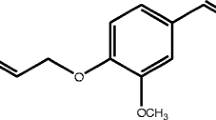Abstract
Beer contains a variety of phenolic compounds. During the brewing process, some of these compounds are removed by polyvinylpolypyrrolidone (PVPP) to prevent haze formation. We have analyzed the phytochemical composition of a PVPP residue as well as of unstabilized beer and isolated a total of 51 compounds. Eight structures were identified as novel, i.e., 2-(4′-hydroxyphenyl)-3,5-dihydroxybenzoic acid (6), 2′-(4″-hydroxyphenyl)isoferulic acid ester (12), 1,2,5,7-tetrahydroxyanthraquinone (23) and 4,7-dihydroxy-5-(2′,4′,6′-trihydroxyphenyl)-indan-1,2-dione (24) from the PVPP residue, and catechin-7-O-β-(6″-O-nicotinoyl)-β-D-glucopyranoside (41), ent-epigallo-catechin-(4αto8, 2αtoOto7)catechin (44), ent-epigallocatechin (4αto6, 2αtoOto7)catechin (45) and 2,3-cis-3,4-trans-2-[2,3-trans-3,3′,4′,5,7-pentahydroxyflavan-8-yl]-4-(3,4-dihydroxyphenyl)3,5,7-trihydroxybenzopyran (46) from the unstabilized beer. Most of the compounds were tested for potential cancer chemopreventive activities in in vitro test systems detecting a modulation of carcinogen metabolism (inhibition of phase 1 cytochrome P450 1A (Cyp1A) activity, induction of NAD(P)H:quinone oxidoreductase (QR) activity) and anti-inflammatory mechanisms (inhibition of lipopolysaccharide (LPS)-mediated induction of inducible nitric oxide synthase (iNOS), inhibition of cyclooxygenase 1 (Cox-1) activity). 1,2,5,7-Tetrahydroxyanthraquinone (23) and xanthohumol (25), a prenylated chalcone derived from hop, were identified as the most potent compounds and were additionally tested for inhibition of chemically-induced preneoplastic lesions in an ex vivo mouse mammary gland organ culture model (MMOC). Importantly, both agents inhibited lesion formation with halfmaximal inhibitory concentrations (IC50) of 0.1 and 0.02 μM, respectively. Our results demonstrate that beer is an interesting source of potential cancer chemopreventive agents and should be further investigated with this respect.
Similar content being viewed by others
References
Alt AP (2001) Untersuchung von Bier und seinen Inhaltsstoffen auf potentielle krebspräventive Aktivität. Dissertation, Naturwissenschaftlich-Technische Fakultät III. Universität des Saarlandes.
Brenner H, Rothenbacher D, Bode G, Marz W, Hoffmeister A & Koenig W (2001) Coronary heart disease risk reduction in a predominantly beer-drinking population. Epidemiology 12: 390–395.
Chèze C, Vercauteren J & Verpoorte R (eds) (2001) Polyphenols, wine and health. Proceedings of the Phytochemical Society of Europe. Vol. 48, Kluwer Academic Publishers, Dordrecht.
Crespi CL, Miller VP & Penman BW (1997) Microtiter plate assays for inhibition of human, drug-metabolizing cytochromes P450. Anal. Biochem. 248: 188–190.
Denke MA (2000) Nutritional and health benefits of beer. Am. J. Med. Sci. 320: 320–326.
Ding AH, Nathan CF & Stuehr DJ (1988) Release of reactive nitrogen intermediates and reactive oxygen intermediates from mouse peritoneal macrophages. Comparison of activating cytokines and evidence for independent production. J. Immunol. 141: 2407–2412.
Gerhauser C, You Y, Liu J, Moriarty RM, Hawthorne M, Mehta RG, Moon RC & Pezzuto JM (1997) Cancer chemopreventive potential of sulforamate, a novel analog of sulforaphane that induces Phase 2 drug-metabolizing enzymes. Cancer Res. 57: 272–278.
Gerhauser C, Alt A, Gamal-Eldeen A, Neumann I, Frank N, Chmiel H, Bartsch H & Becker H (2001) Antioxidant and Radicalscavenging Potential of Phenolic Constituents of Beer. Proc. Am. Assoc. Cancer Res. 42: #103. Publication in preparation.
Gerhauser C, Klimo K, Heiss E, Neumann I, Gamal Eldeen A, Knauft J, Liu G, Sitthimonchai S, Frank N (2002a) Mechanismbased in vitro screening of potential cancer chemopreventive agents. Mut. Res., in press.
Gerhauser C, Alt A, Heiss E, Gamal-Eldeen A, Klimo K, Knauft J, Neumann I, Scherf HR, Frank N, Bartsch H & Becker H (2002b) Cancer chemopreventive activity of Xanthohumol, a natural product derived from hop. Mol. Cancer Ther. 1: 959–969.
Heiss E, Herhaus C, Klimo K, Bartsch H & Gerhauser C (2001) Nuclear factor-κB is a molecular target for sulforaphanemediated anti-inflammatory mechanisms. J. Biol. Chem. 276: 32008–32015.
Jang M, Cai L, Udeani GO, Slowing KV, Thomas CF, Beecher CW, Fong HH, Farnsworth NR, Kinghorn AD, Mehta RG, Moon RC & Pezzuto JM (1997) Cancer chemopreventive activity of resveratrol, a natural product derived from grapes. Science 275: 218–220.
McMurrough L & Baert T (1994) Identification of proanthocyanidines in beer and their direct measurements with a dual electrode electrochemical detector. J. Inst. Brew. 100: 409–416.
Steynberg JP, Bezuidenhout BCB, Burger JFW, Young DA & Ferreira D (1990) Oligomeric flavonoids. Part 7. Novel base catalysed pyran rearrangements of procyanidins. J. Chem. Soc. Perkin. Trans. I: 203–208.
Author information
Authors and Affiliations
Rights and permissions
About this article
Cite this article
Gerhäuser, C., Alt, A., Klimo, K. et al. Isolation and potential cancer chemopreventive activities of phenolic compounds of beer. Phytochemistry Reviews 1, 369–377 (2002). https://doi.org/10.1023/A:1026082325529
Issue Date:
DOI: https://doi.org/10.1023/A:1026082325529




